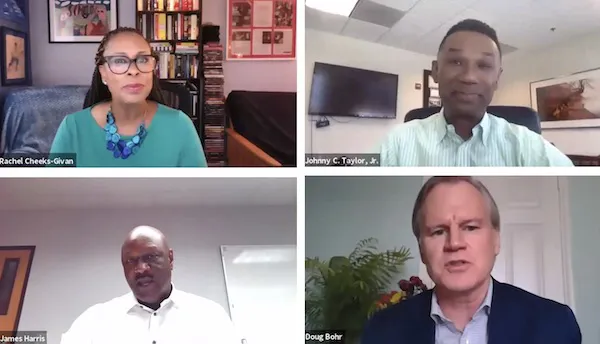The topic of diversity and inclusion has been previously addressed at PMA’s virtual town hall series and to emphasize the importance and gravity of the topic, PMA readdressed it in this week’s virtual town hall. Since the first town hall discussion on the topics, PMA’s Center for Growing Talent has taken several steps to fortify their approach to diversity and inclusion within the organization and within the industry.

PMA and Center for Growing Talent take steps
PMA and the Center for Growing have set up a task force to explore how they can advance diversity and inclusion among their members and the industry. Doug Bohr, Director of the Center for Growing Talent explains: “The task force’s work is focused on four main objectives. The first one is to educate ourselves and our organization as to how to define and engender a more diverse and inclusive workplace. Secondly, to encourage and support members’ efforts to promote diversity and inclusion in ways that benefit their business and their employees. Third, to coordinate outreach to, and the development of, minority-owned and operated companies in our industry and build a more diverse and inclusive membership. The fourth and final point is to identify ways to attract and develop talent by marketing and promoting career opportunities in our industry through the work of the Center for Growing Talent.”
He adds: “It is our sincere hope that our work over the coming year will build a lasting and sustainable foundation from which to create a more diverse, inclusive and equitable future that drives our members' ability to engage today’s consumers and market growth, attract and develops the best and brightest talent and ultimately helps us grow a healthier world in every way possible.”
The dimensions of diversity
The panelists at this discussion were Johnny C. Taylor Jr., President and CEO of the Society for Human Resource Management, Rachel Cheeks-Givan, Global Director of Diversity and Inclusion at Pfizer and James Harris, the Director of Diversity and Inclusion at H-E-B. One of the topics discussed by the panelists was that of the wide variety of dimensions diversity has, and how to integrate these into a workplace. Taylor Jr. says: “There are at least 20-25 different dimensions of diversity. There is the civil rights dimension, which includes race, age, gender, ethnicity and more, but then there is also the diversity of thought and perspective. Political affiliation, for example, is an aspect of diversity too. Broadly taken, diversity just refers to bringing in different types of people.”
When companies work on increasing the diversity of their staff, one of the challenges they’re met with is ensuring that the workplace is not only diverse but also inclusive. “When you’re bringing people into the organization, you have to make sure that they’re fitting in, that they feel like they belong. You have to value them for the perspectives that you hired them for. The leaders need to leverage these different points of view, otherwise, you lose out on that diversity of perspective,” Cheeks-Givan comments.
From the employee’s perspective, it’s also important to understand the culture of your workplace, Harris says. “You have to understand the culture of the organization you work for. There are different rules, both written and unwritten, and you have to understand how the company works and how new ideas are brought in. How does the company drive market shares and what are their marketplace preferences? That is why it is very important that a company understands its own culture, how they go to market, and then align that with their diversity and inclusion strategies."
Small and medium companies compared to large companies
The way in which diversity and inclusion are approached within a company can be very different depending on a company’s size. “70% of American companies fall in the small to medium categories. Often, these companies struggle a bit more with this: by nature they have less diversity because they have fewer employees and they have fewer resources for implementing change,” Taylor Jr. says.
Harris points out, however, that a smaller size company also has a distinct advantage: “Often, for small or emerging companies it’s actually easier to pivot because there are much fewer layers to get through to get things moving and to make real change happen within the organization, compared with large companies.”
The broken rung
Finally, an important topic is that of the ‘broken rung.’ “Talent acquisition is important to diversifying your staff, but promotional efforts are just as important,” Taylor Jr. says. “There are a lot of companies who are very diverse at their base, but as you look at more senior positions the diversity disappears.”
So how can companies address this and help minorities in the lower positions advance through the company? Cheeks-Givan says: “Putting programs in place to help with advancement through a company can help with this. We had a program that gave people the opportunity to interact with the company’s leaders and decision-makers. It’s mostly about visibility, especially in larger companies. We can help people develop the skills necessary to move up, but then we also have to put them in front of the right people so these skills can be recognized.”
Another approach to this is through mentor programs, Harris says. “Having sponsors and mentors helps not only with recruiting but also retention. Employee development and promotion is very important to get to the goal of employee retention. There are a lot of different strategies for approaching this and sponsors are a good way to go. To have people who advocate for you in promotional spaces.”
“When there is civil unrest, many companies are very quick to write a check and a statement, but I believe it’s more important to focus on internal initiatives to fix that broken rung on the ladder and create new opportunities within the organization,” Taylor Jr. adds, concluding: “There is no quick fix; the real fix has be long-term.”
